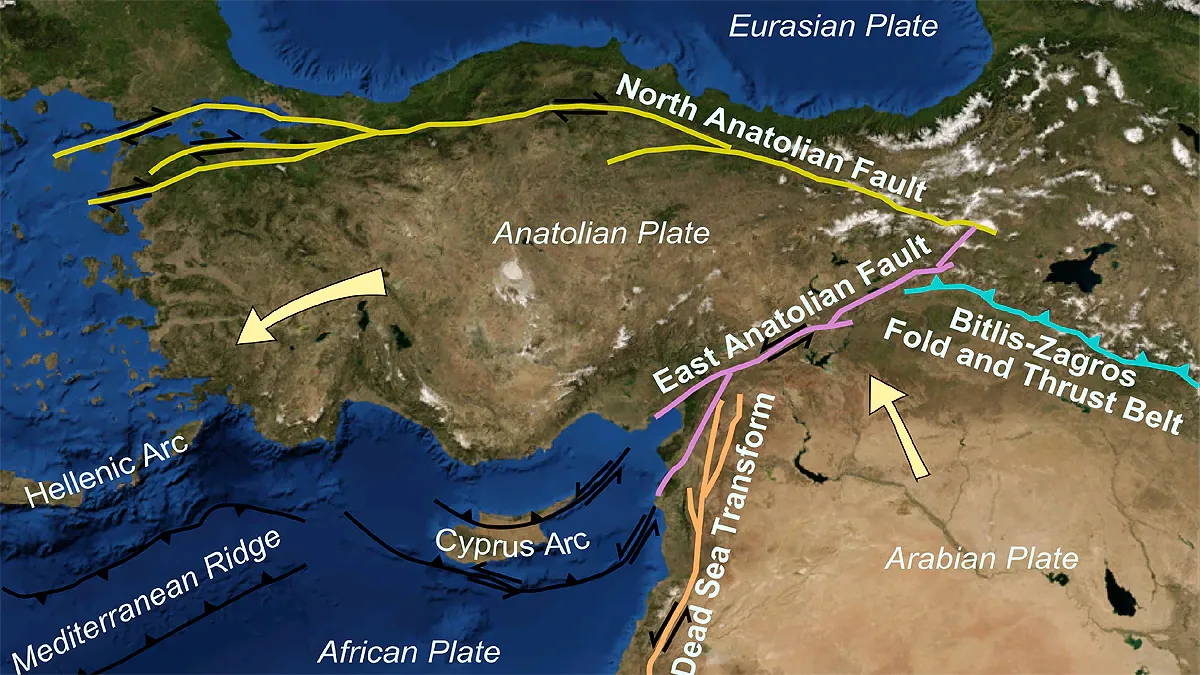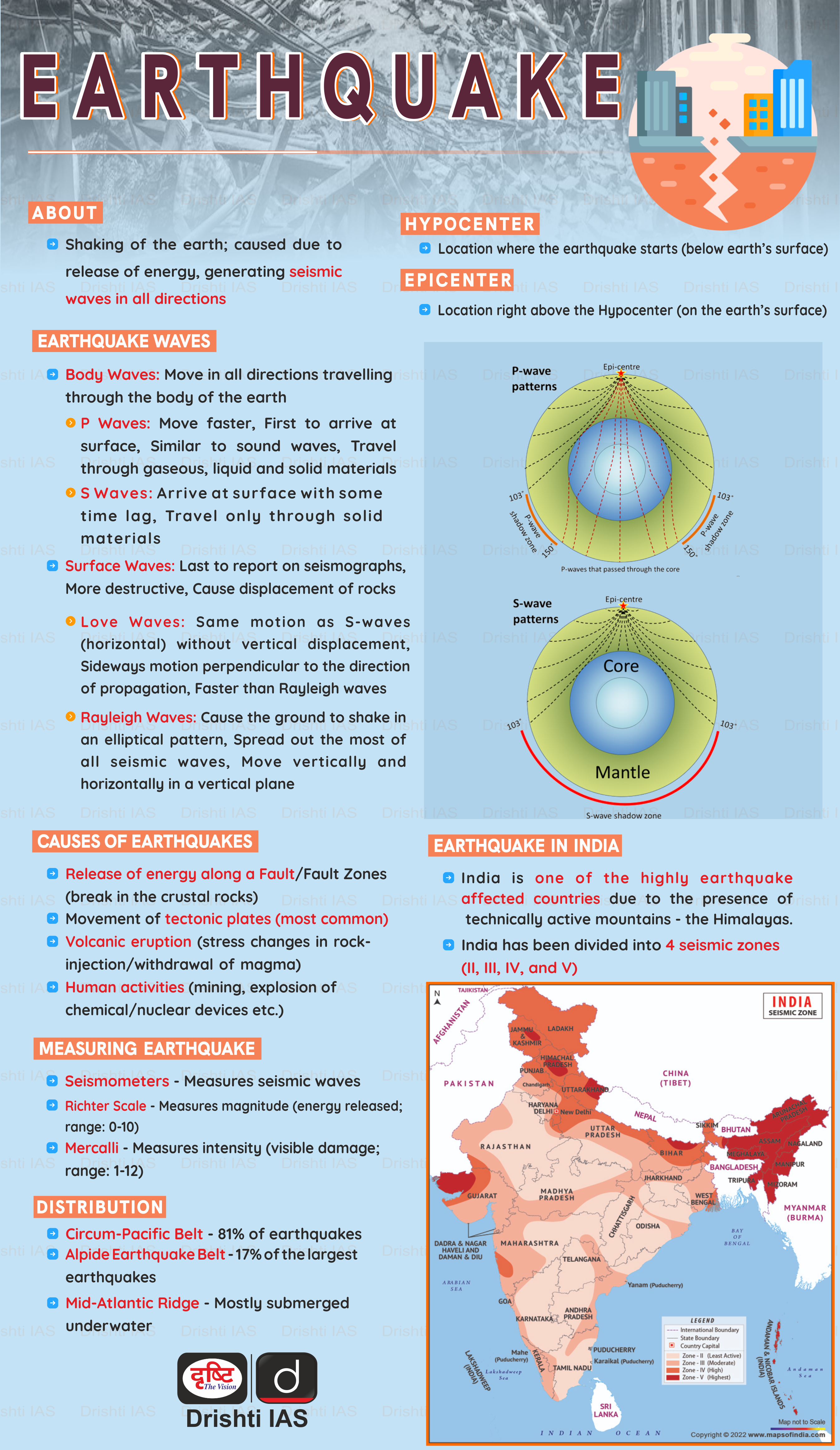Earthquakes in Turkey and Causes | 07 Feb 2023
Prelims: Tectonic Plates, Types of Earthquakes, Earthquake, its Distribution and Types, Strike-Slip Earthquake.
Mains: Earthquake, its types and Distribution.
Why in News?
Recently, powerful tremors were felt in Turkey after an earthquake of magnitude 7.8 struck along a well-known fault line called the Anatolia tectonic block.
- The earthquakes emerged from relatively shallow depths and were a “strike-slip quake”.
- It is being described as the strongest Earthquake that Turkey has experienced in over a century and the worst disaster since 1939. The 1939 earthquake was the Erzincan Earthquake that had caused “extreme damage in the Erzincan Plain and the Kelkit River Valley.
What Makes Turkey Prone to Earthquakes?
- In the Eastern Mediterranean region comprising Turkey, Syria and Jordan, tectonics are dominated by complex interactions between the African, Arabian, and Eurasian tectonic plates, and the Anatolian tectonic block.
- Turkey sits on the Anatolian tectonic plate, which borders two major faults, the North Anatolian Fault (NAF) that cuts across the country from west to east, and the East Anatolian Fault (EAF) in the southeast.
- The NAF line is the meeting point of the Eurasian and Anatolian tectonic plates that is known to be “Particularly Devastating”.
- NAF is right-lateral strike-slip structure in northern Turkey accommodating much of the translational motion of the Anatolia block westwards with respect to Eurasia and Africa.
- The EAF is the tectonic boundary between the Anatolian Plate and the northward-moving Arabian Plate. It runs 650 kilometers from eastern Turkey and into the Mediterranean.
- The NAF line is the meeting point of the Eurasian and Anatolian tectonic plates that is known to be “Particularly Devastating”.
- In addition to this, the Aegean Sea Plate, located in the eastern Mediterranean Sea under southern Greece and western Turkey, is also a source of seismic activity in the region.
- According to one estimate, almost 95% of Turkey's land mass is prone to earthquakes, while about a third of the country is at high risk, including the areas around the major cities of Istanbul and Izmir and the region of East Anatolia.
How Regular Earthquake is Different from Strike Slip Earthquake?
- Plate Movement: In a strike-slip earthquake, two tectonic plates move horizontally past each other, whereas in a regular earthquake, the movement is vertical.
- Fault Zones, Tectonic Earthquakes, Volcanic Earthquake, Human Induced Earthquakes are the different types of Earthquakes.
- Fault Type and Location: Strike-slip earthquakes occur along transform boundaries such as the San Andreas Fault in California while regular earthquakes occur along divergent or convergent plate boundaries where the plates move vertically such as along the Pacific "Ring of Fire.
- Causes: The cause of strike-slip fault earthquakes is due to the movement of the two plates against one another and the release of built-up strain.
Do Shallow Earthquake cause greater Damage?
- A shallow earthquake is an earthquake that occurs at a shallow depth, usually within the Earth's crust, near the surface. They typically have a depth of less than 70 km and can result in strong ground shaking and surface faulting.
- They are often more damaging than deep earthquakes because the energy from the seismic waves is released closer to the surface, leading to stronger ground motion and more intense shaking.
- This can cause damage to buildings and infrastructure, as well as triggers landslides, rockfalls, and other secondary hazards.
- However, the amount of damage caused by an earthquake depends on a number of factors, including the magnitude of the earthquake, the distance from the epicenter, the depth of the earthquake, the type of soil and geological conditions at the surface.
UPSC Civil Services Examination Previous Year Question (PYQ)
Q. The frequency of earthquakes appears to have increased in the Indian subcontinent. However, India’s preparedness for mitigating their impact has significant gaps. Discuss various aspects. (2015)
Q. Discuss about the vulnerability of India to earthquake related hazards. Give examples including the salient features of major disasters caused by earthquakes in different parts of India during the last three decades. (2021)



